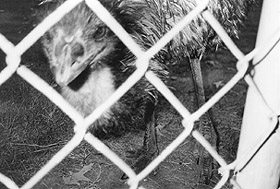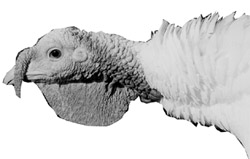 a scrub land in the middle of Australia lives a magical creature.
Shh If you're quiet -- wait There! Can you hear it?
a scrub land in the middle of Australia lives a magical creature.
Shh If you're quiet -- wait There! Can you hear it?Not Just for Kids
Meet Emily and Elmer Emu
story and photo by Junior Reporter Ariel Brumbaugh
Somewhere far away in  a scrub land in the middle of Australia lives a magical creature.
Shh If you're quiet -- wait There! Can you hear it?
a scrub land in the middle of Australia lives a magical creature.
Shh If you're quiet -- wait There! Can you hear it?
That drumming sound is not an aborigine beating on a drum. It's an emu. Drumming is how the female converses with males during mating season. The male makes a sort of snorting noise that is not as loud or defined as the female's.
The emu is quite large, nearly six feet tall. It is brown-black except for blue markings around the eyes and a black beak. Its head is shaggy, and its quills are long and disheveled.
The emu eats coarse grasses and succulent plants, fruit, flowers, seed and sometimes insects. To find food in the dry stretches of
Australia, emus travel as many as 620 miles in a year, following the rainfall. This big bird can't fly, but it can run faster than a person.
I didn't have to go all the way to Australia to meet an emu. I found some of the big birds right here in Anne Arundel County, on the West River emu farm of Joan Collinson.
Joan Collinson is a nurse, but in her spare time she raises emus.
Emily and Elmer are the primary emus among the eight pairs Ms. Collinson owns. This means that every year for about 30 years, these two will give birth. The birds have eight to 20 eggs. The eggs are large and blue-green.
 After three eggs have been laid,
Joan takes the eggs and incubates them until they hatch. In the wild, the
male does all the work, keeping the eggs warm for 56 days. When they hatch,
he feeds them until they can live on thir own. That's about 18 months.
After three eggs have been laid,
Joan takes the eggs and incubates them until they hatch. In the wild, the
male does all the work, keeping the eggs warm for 56 days. When they hatch,
he feeds them until they can live on thir own. That's about 18 months.
But on the emu farm, all the little emus get sold for many different things. The leathery skin on the legs is used for belts and boots. The toenails are used for
jewelry because they are very hard. The feathers are the most valuable part of all. The oil in the feathers is used for shampoo, facial cream, pain killer and muscle relaxers. The eggs are even used in craft stores, where they are sold for about $10 each.
There is even such a thing as emu meat. Ms. Collinson says it looks and
tastes a lot like beef. Aren't you glad you didn't eat emu for Thanksgiving?
Can you identify these other birds that might end up on your plate?
ANSWERS :Like emus, ostriches (left) are becoming a popular alternative to red meat in the U.S. And the bird on your right? You guessed it! A turkey.
| Back to Archives |
Volume VI Number 48
December 3-9, 1998
New Bay Times
| Homepage |